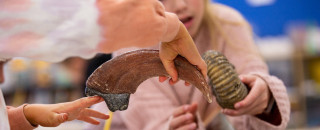NHMU Educators Reach Into Utah Classrooms
Students work with fossils as part of NHMU's Museum on the Move program. ©NHMU
By Michael Mozdy
NHMU is more than a destination museum housing incredible collections; it is a serious education partner with Utah schools. From the NSF-funded, immersive Research Quest program to the peer-focused Youth Teaching Youth program, a host of science educators are using innovative methods to complement the Utah state curriculum. In fact, NHMU is part of the Informal Science Education Enhancement (iSEE) partnership with the state of Utah. iSEE organizations receive funding from the Utah State legislature to provide science experiences to students and teachers across Utah that would otherwise not be available to them. NHMU educators stay up-to-date with state standards, priorities, and practices to make sure these experiences are best poised to accompany classroom activities.
We would like to highlight three energetic, highly intelligent women out of a brigade of talented NHMU employees helping to educate Utah students.
Katie Worthen
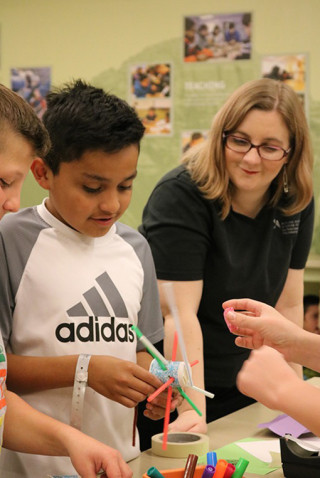
Katie is the STEM Lab Coordinator at the museum, (STEM = Science, Technology, Engineering, and Math) which is a part of the larger Field Trip and Teacher Resources division of the Education Department. When teachers bring their students to the museum for field trips, Katie is prepared to offer a hands-on learning experience for small groups.
“The STEM lab is very problem-solution focused,” Katie explains. “I set up a practical problem with a range of science, math, and engineering tools they can use to find unique solutions.”
One example is her bird beak prosthetic activity. As a way to engage in the real-world challenge of making beak prosthetics for injured birds, “we start with a paper cup that is a model of a damaged bird beak,” she explains. The students can use a wide variety of materials to make a prosthetic. Then, they put their designs into practice with 3 different tests: can your bird eat, can they build a nest, can they preen? “It’s a great way to join zoology and anatomy with the design-build-test paradigm in engineering,” she says.
Other activities Katie has implemented are making Viking boats and testing different types of spider webs. This hands-on work always has a connection to exhibits currently in the museum. “I love to blow their minds with how they can engage in the science of these topics,” she adds.
Katie is a great resource for school groups – she has been at museums for 16 years and at NHMU for 7 of those. With a masters in Geology and another in Museum Practices, she is well-qualified to also be teaching professional development workshops for elementary school teachers. She covers aspects of curriculum and classroom management, but more importantly to her, she imparts a passion for STEM.
“I have worked with some teachers who are unenthusiastic about science,” she states, “and after some time, I was able to have them see how it can be creative and fun.”
Glynis Bawden
NHMU also takes activities into classrooms throughout the state. The Museum on the Move program goes to fourth grade classrooms in every public school in Utah, including public charter schools. Glynis Bawden is the School Outreach and Professional Development Manager, overseeing four traveling science educators who storm across the state.
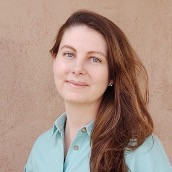
Where Katie bubbles with energy, ready to catalyze the nearest grade schooler into action, Glynis exhibits a calm, measured demeanor that surely comes in handy when coordinating a massive schedule of travel and workshops. Her team visits hundreds of classrooms and provides workshops for 250 to 300 teachers each year. Many workshops are scheduled to coincide with Museum on the Move classroom visits, but others are held are various locations throughout the year, such as the Cambodian Buddhist temple (in conjunction with the Angkor exhibit at the museum) and the Utah Museum of Fine Arts.
The state science standards inform the curricula Glynis’s team develops. “We do a lot of work when we define each topic to make sure we’re supporting teachers and their curriculum needs,” she emphasizes. “The lessons are very carefully created, but the life of an outreach educator is one where you have to adapt to the situation, ordered or chaotic, and meet the students where they are.”
During this time of year, spring, Glynis notes that some teachers use the classroom visits as a nice review of past material while others use them to help introduce new topics they are about to teach. In either case, the Museum on the Move educators let the students steer much of the discussion.
“To use some pedagogy buzz words,” she says, “The work we do with Museum on the Move is object-based, inquiry-based, and student-led.” She describes how the traveling educators take museum objects, like casts of dinosaur bones, with them into classrooms and then start asking questions alongside the students. Questions like “which of these objects is interesting to you?” (hence, student-led), and “how would you describe this if you couldn’t look up a description for it?”
Such work takes a wide breadth of knowledge and a masterful ability to handle curve balls when the students throw them at you.
Aidan Bailey
Perhaps no one embodies these traits more than Aidan Bailey, one of the School Outreach Coordinators and a veritable tornado of educational energy. Aidan started as an informal educator in 2008 and worked in zoos for a long time, where she continued to hone her background in zoology. She is thrilled to be working in museums again, particularly for NHMU, where she has been for the past 5 years.
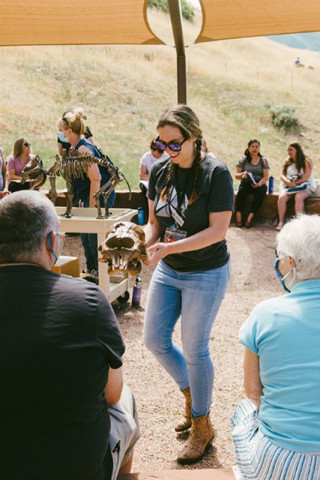
In addition to an innate fearlessness, Aidan explains that she and the other outreach educators often use a “yes-and” technique from the world of improv theater with students. This means that first they affirm and validate the student’s observation; “Acknowledging their bits of expertise is very important,” she declares. The “and” part of the equation is to build upon their initial statement and bring students deeper into the science. “This part lets them see themselves as the scientists and inquiring minds they truly are,” she says.
Of course, kids can say all kinds of things, some of them seemingly unconnected even to the objects that the educators are bringing into the classroom. “None of this is really scripted,” Aidan laughs, despite the fact that they have solid curriculum goals to hit. “But building on their questions and their expertise – really fostering it – is one of the things that makes it memorable and valuable for them.”
Another aspect of Museum on the Move that promotes student engagement is the fact that the educators are bringing objects from NHMU, which means they are from Utah, some of which could be found in students’ own back yards. They can make ready connections to things like robin skulls and rock samples.
Aidan insists that adults don’t have to “dumb down” science for kids and that a surprising level of sophistication can be reached. “You just need to explain it in a way that is relevant to their experience and knowledge base,” she claims.
“I regularly ask what their favorite prehistoric animal is and kids will pull out some fairly deep-cut dinosaurs like Dilophosaurus, Giganotosaurus, Elasmosaurus,” she says. “This is where they are revealing their own expertise.”
Aidan also notes that just being introduced as a scientist opens the eyes of some students. “Not all of us are in lab coats at benches,” she declares. Each of the outreach educators brings an area of expertise and a unique perspective to the students – zoology for Aidan and geology for Glynis, who gets to regale students with her experiences doing field work on volcanoes.
The Forefront of Diversity and Inclusion
The point of iSEE funding from the state legislature is to bring dynamic science education to classrooms that would not otherwise have these opportunities. This achieves an important equity goal for education in Utah. What’s more, any teacher can tell you that it takes work to involve the full diversity of students in a classroom, from the energetic to the shy, the over achievers to the ones who clearly had a bad night’s sleep and maybe not enough food. Thus, the outreach educators are in a natural position to fully embrace the broad goals of equity, diversity, and inclusion.
“In the museum world,” Glynis states, “it’s often the education teams that are at the forefront of diversity and inclusion work. They are there to make everyone feel like they are welcome to participate.”
And they truly are seeking to include everyone in learning rather than more shallowly participate in a cultural moment around diversity and inclusion. In addition to the classroom techniques that encourage every student, the education team affirms cultural diversity throughout its work.
Respect for other cultures is a part of the cultural DNA of NHMU, and the educators “try to be subtle and diplomatic to show why inclusion and diversity is important,” explains Katie.
For example, when teaching archaeology, “we always begin with a map that identifies the tribes that were in the state when European settlers came here,” illustrates Glynis. “Then we ask them to find themselves on the map and the conversation continues. They can see how they inhabit a land that has been shared for centuries.”
The team does not treat other cultures as if they were dead and gone. “As educators, we don’t speak on behalf of people but instead elevate the voices of others in the community,” says Aidan. For example, recently they invited Cambodian community partners to participate in teacher workshops, in conjunction with the Angkor exhibit at NHMU. As another example of cultural groups speaking on their own behalf, indigenous Mexican artists have participated in teacher workshops.
In terms of science education, this introduces another interesting wrinkle: indigenous cultures and those from other parts of the world approach scientific knowledge differently. Traditional medicine, for instance, is handed down orally between generations and comprises a significant trove of scientific knowledge. What’s more, stories and myths found in other cultures display an array of scientific knowledge compiled in a way different from the modern scientific method.
“Whether informal or formal, these methods share much with modern science in that they are asking questions and making observations,” reflects Glynis. “Our job as educators is that of an interpreter – whether it is from modern science or traditional science, we are interpreting for students and helping them understand the underlying knowledge,” she adds.
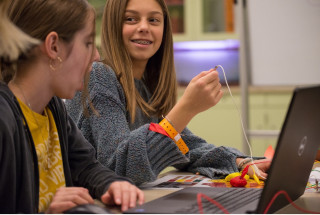
We salute the work of these three women and of all the educators at NHMU. We greatly appreciate their efforts to help new generations be actively engaged in the world around them.
Michael Mozdy is the Associate Director for Science Communications in the Department of Radiology and Imaging Sciences at the University of Utah and a part-time contributor to the Natural History Museum of Utah. Our mission is to illuminate the natural world and the place of humans within it. In addition to housing outstanding exhibits for the public, NHMU is a research museum. Learn more.
